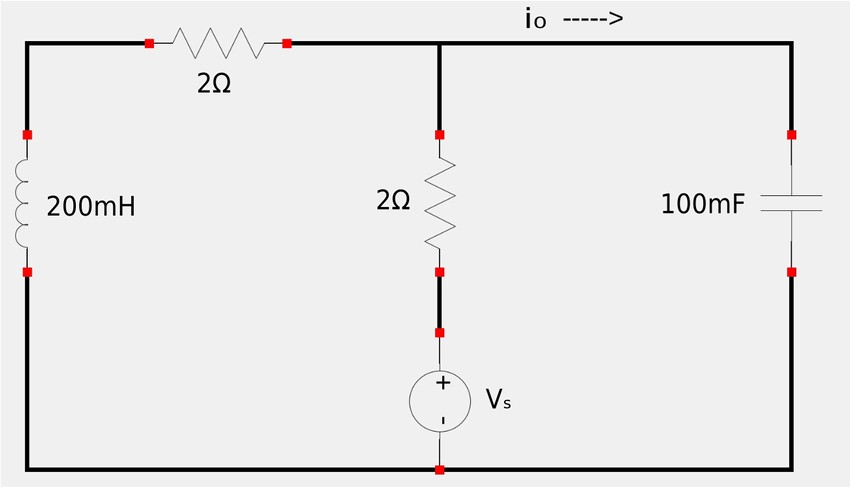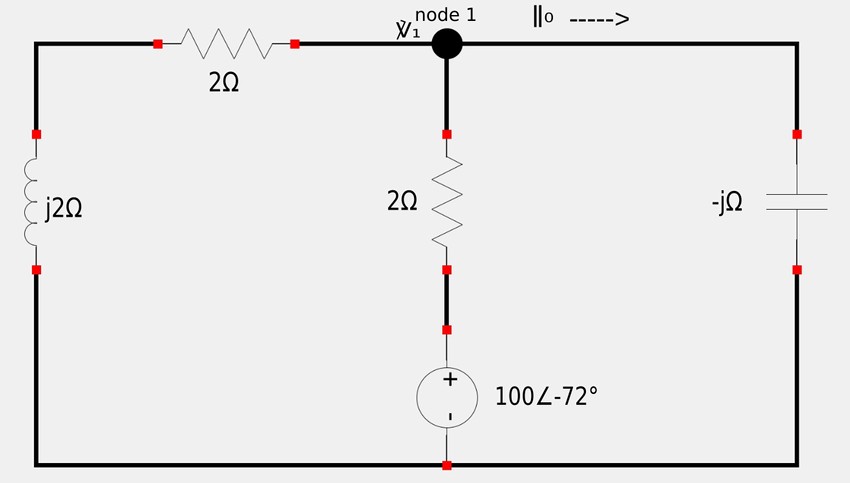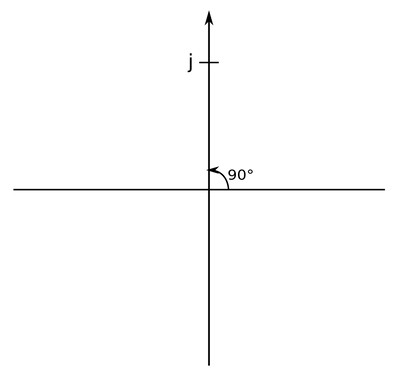For the following circuit, let:
$$ V_s = [100\sin(10t+18^{\circ})] V $$ ...and determine the value for "io" in the time domain.

Using either trig identities or the graphical technique described in the Sinusoids tutorial, we begin by converting the voltage source (Vs) to a cosine term with a positive amplitude: $$ V_s = 100\sin(10t+18^{\circ}) $$ $$ = 100\cos(10t+18^{\circ} - 90^{\circ}) $$ $$ V_s = 100\cos(10t - 72^{\circ}) $$ If we convert this to phasor notation we get: $$ \mathbb{V}_s = 100\angle(-72^{\circ}) $$ Using the definitions of the impedances of resistors, inductors and capacitors that we learned in our Intro to impedance and admittance tutorial we now determine the impedance values of the elements in our circuit:
Impedance of 200mH inductor:
$$ \mathbb{Z}_L = j\omega L $$ $$ \mathbb{Z}_L = j(10)(200 \times 10^{-3}) $$ $$ \mathbb{Z}_L = j2 \Omega $$
Impedance of 100mF capacitor:
$$ \mathbb{Z}_C = \frac{-j}{\omega C} $$ $$ = \frac{-j}{10(100 \times 10^{-3})} $$ $$ \mathbb{Z}_C = -j \Omega $$
The impedance values of the resistors are simply the resistance values themselves. We now redraw our circuit with our newly determined impedance values in the frequency domain:

Apply Kirchoff's Current Law (KCL) at node 1:
$$ \frac{\mathbb{V}_1}{2+j2} + \frac{\mathbb{V}_1}{-j} + \frac{\mathbb{V}_1 - 100\angle(-72^{\circ})}{2} = 0 $$ Goal: solve for phasor voltage at node 1 $$ \mathbb{V}_1 \Big[ \frac{1}{2+j2} + j + \frac{1}{2} \Big] = 50\angle(-72^{\circ}) $$ In order to clear the complex terms from the denominator, we multiply by the complex conjugate: $$ \mathbb{V}_1 \Big[ \frac{1}{2+j2} \Big( \frac{2-j2}{2-j2} \Big) + j + \frac{1}{2} \Big] $$ $$ = 50\angle(-72^{\circ}) $$ $$ \mathbb{V}_1 \Big[ \frac{2-j2}{8} + j + \frac{1}{2} \Big] = 50\angle(-72^{\circ}) $$ $$ \mathbb{V}_1 \Big[ \frac{1}{4} - \frac{j}{4} + j + \frac{1}{2} \Big] = 50\angle(-72^{\circ}) $$ $$ \mathbb{V}_1 [0.75 + j0.75 ] = 50\angle(-72^{\circ}) \qquad(Eqn \; 1)$$
We will do some side-work to convert the complex term inside the brackets of equation #1 from rectangular form to polar form: $$ r = \sqrt{(0.75)^2 + (0.75)^2} $$ $$ r = 1.061 $$ $$ \phi_{ref} = \phi = tan^{-1} \Big( \frac{0.75}{0.75} \Big) $$ $$ \phi = 45^{\circ} $$ We now substitute this back into equation #1:
$$ \mathbb{V}_1 [1.061 \angle 45^{\circ}] = 50\angle(-72^{\circ}) $$ $$ \mathbb{V}_1 = \frac{50\angle(-72^{\circ})}{1.061 \angle 45^{\circ}} $$ Using the rules of operations for complex numbers found in the complex numbers page: $$ \mathbb{V}_1 = \frac{50}{1.061} \angle (-72-45)^{\circ} $$
This gives us the phasor voltage at node 1 $$ \mathbb{V}_1 = 47.13 \angle (-117)^{\circ} $$
We now proceed to determine the phasor current flowing through the 100mF capacitor (which has a -j ohm impedance value) $$ \mathbb{I}_0 = \frac{\mathbb{V}_1}{-j} = \mathbb{V}_1 j \qquad(Eqn \; 2)$$
Converting "j" to polar notation:
 $$ j = 1\angle 90^{\circ} $$
Now substitute this and our expression for the phasor voltage at node 1 into equation #2:
$$ j = 1\angle 90^{\circ} $$
Now substitute this and our expression for the phasor voltage at node 1 into equation #2:
$$ \mathbb{I}_0 = \Big( 47.13 \angle (-117)^{\circ} \Big) \Big( 1\angle 90^{\circ} \Big) $$ Again we use the rules of operations for complex numbers found in the complex numbers page: $$ \mathbb{I}_0 = (47.13)(1) \angle(-117+90)^{\circ} $$ $$ \mathbb{I}_0 = 47.13 \angle (-27)^{\circ} $$ If we convert this to exponential form we get: $$ \mathbb{I}_0 = 47.13 e^{j(-27^{\circ})} $$
Convert phasor current to current in the time domain:
In order to do so we multiply the phasor current by e^(jwt) and take the real part of the result. Note that omega=10 rad/s: $$ i_0(t) = R_e \Big\{ 47.13e^{j(-27^{\circ})} e^{j(10t)} \Big\} $$ $$ i_0(t) = R_e \Big\{ 47.13e^{j(10t-27^{\circ})} \Big\} \qquad(Eqn \; 3)$$
Recall Euhler's identity: $$ e^{j\phi} = \cos\phi + j \sin \phi $$ ...and apply it to equation #3:
$$ i_0(t) = R_e \Big\{ 47.13\cos(10t-27^{\circ}) $$ $$ + j47.13 \sin(10t-27^{\circ}) \Big\} $$ If we evaluate the above expression we get: $$ i_0(t) = \Big[ 47.13\cos(10t-27^{\circ}) \Big] A$$ And if we convert this to a sine term with a positive amplitude we get: $$ i_0(t) = \Big[ 47.13\sin(10t-27^{\circ}+90^{\circ}) \Big] A$$ ...which gives us the final answer:
Current in the time-domain:
$$ i_0(t) = \Big[ 47.13\sin(10t+63^{\circ}) \Big] A$$
